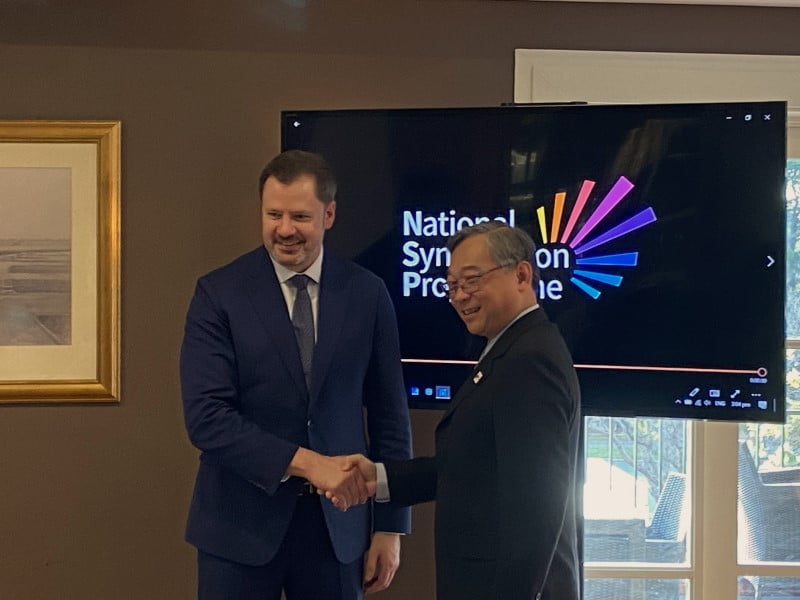The Australian Nuclear Science and Technology Organisation is the first partner to sign onto the Singapore Government-funded National Synchrotron Programme, hosted by the National University of Singapore.
The National University of Singapore (NUS) agreement was signed on Monday by director of the Australian Synchrotron, Professor Andrew Peele, and NUS deputy president (research and technology) Professor Chen Tsuhan. It was witnessed by Minister for Industry and Science Ed Husic and Singapore’s Minister for Industry and Trade Gan Kim Yong.

Synchrotrons are large accelerators that have a circular or curved shape that perpetually circulate a beam of electrons. This emits electromagnetic radiation across a range of wavelengths which can be channelled down pipelines, or beamlines, enabling molecular and atomic scale analysis.
Researchers based at Singaporean institutions will have priority access to the Australian Nuclear Science and Technology Organisation’s (ANSTO) synchrotron in Melbourne over a five-year period.
The program pre-emptively allocates beamtime to the SGD$16 million Singaporean program. It is also a collaborative platform that will allow Singapore-based researchers to undertake research attachments at the Australian Synchrotron.
Australian Synchrotron director Professor Andrew Peele argued that while access to the beamlines is important, “it’s actually that partnership and collaboration between researchers across the two domains [that] I think is going to be the real secret sauce in this synchrotron access program”.
NUS currently operates the Singapore Synchrotron Light Source (SSLS), which emits radiation at energies suited to studying the physical sciences such as physics, chemistry, and engineering, according to Singapore’s National Synchrotron Programme director Professor Mark Breese.
The Australian Synchrotron is capable of producing light a million times brighter than the sun. It will give NUS-based researchers access to hard X-ray beams used for bioscience research which is unavailable at the SSLS. The capabilities facilitated by this include macromolecular crystallography, phase contrast imaging, X-ray scattering, and absorption.
Minister for Industry and Science Ed Husic said the agreement is proof that the Australian Synchrotron and the Australian Synchrotron Research Program are recognised internationally.
At the signing event, Professor Peele noted that Australia has “about a billion dollars in research infrastructure assets, and the Australian Synchrotron represents about a third of that capital value”. The 2016-17 federal Budget included $520 million in operational funding for the synchrotron over 10 years.
Generally, the Australian synchrotron has sufficient beamline capacity to service about 1,000 experiments annually. The Australian synchrotron runs 24 hours a day and features 10 beamlines, with an additional eight expected to be operational by 2024.
Singapore’s National Synchrotron Program is a national platform funded by the country’s National Research Foundation (NRF). Negotiations between NUS and ANSTO were facilitated by the NRF, lasting around two years. It falls under the Singapore-International Synchrotron Access Programme, which will provide synchrotron access to Singapore-based researchers across Asia and Oceania.
ANSTO chief executive Shaun Jenkinson acknowledged Singapore’s “vibrant research community” and said he hopes the synchrotron agreement will foster stronger research collaborations with Australian scientists.
“[Singaporean] research interests can be covered in part if not in whole by some of the interactions you will have with the Australians in control. ANSTO is a proudly collaborative organisation. What is really important is to take [memorandums of understanding] and move them into action,” Mr Jenkinson said.
The first call for whitepaper applications from researchers based at Singaporean institutions opened on Tuesday. Beamtime in the Australian Synchrotron will be allocated for the period between May to August 2023. The NRF will cover the cost of beamtime access and travel for successful applicants.
The agreement was signed ahead of the 7th Singapore-Australia Annual Leaders’ Meeting on Tuesday which marked the first official in-person meeting between Prime Minister Anthony Albanese and Singaporean Prime Minister Lee Hsien Loong.
An agreement which similarly granted priority beamline access was signed with the New Zealand Synchrotron group in 2017, which was jointly funded by university and research institute members as well as the New Zealand Government.
Researchers who intend to publish the results of their experiments in open literature and are selected through a peer-review application process are granted free access to the synchrotron. Commercial users must pay to access the synchrotron but do not need to disclose their results.
Do you know more? Contact James Riley via Email.

